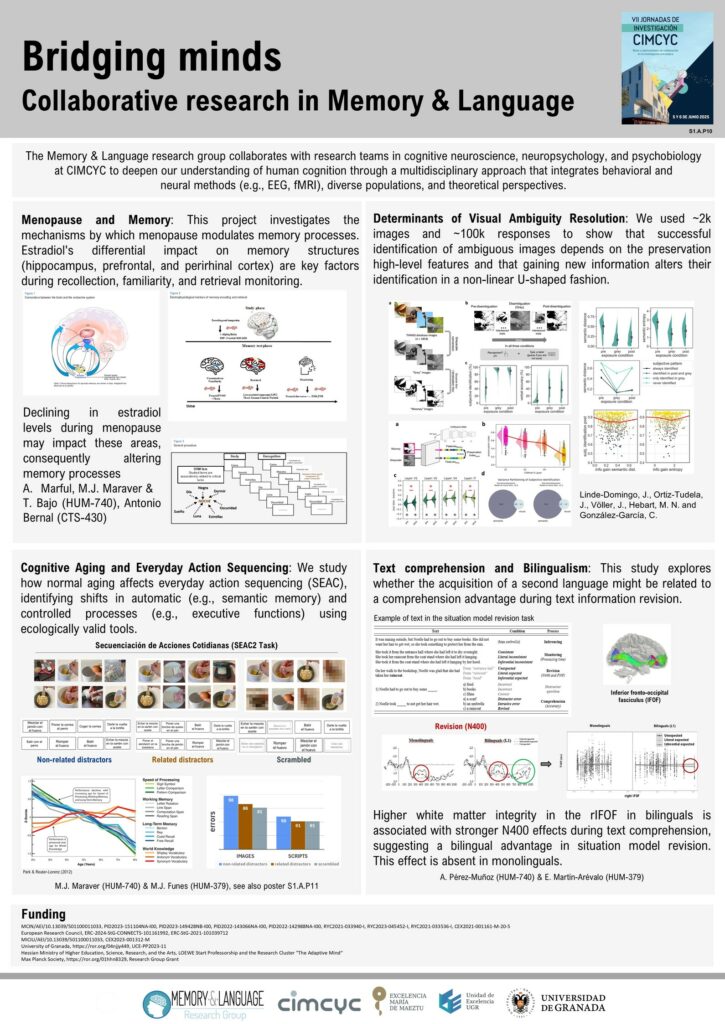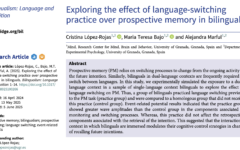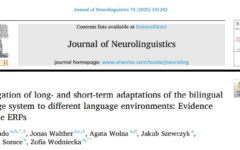VII Jornadas de Investigación CIMCYC
junio 10, 2025 2025-06-12 9:18VII Jornadas de Investigación CIMCYC
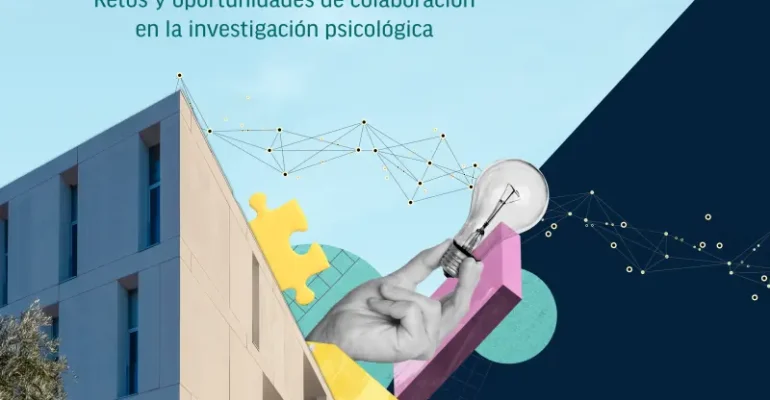
VII Jornadas de Investigación CIMCYC
La semana pasada, nuestro grupo de investigación Memoria y Lenguaje participó en las VII Jornadas de Investigación del CIMCYC. La temática de este año fue la importancia de la colaboración interdisciplinaria para la investigación en Psicología. A lo largo de la jornada, se presentaron pósteres de investigaciones innovadoras y se llevaron a cabo talleres prácticos que fomentaron el diálogo entre los distintos grupos de las diversas áreas de la Psicología que conforman el CIMCYC.
Nuestro grupo tuvo una destacada participación, presentando cinco pósteres que resumen nuestras líneas de investigación más recientes. Cuatro de ellos se presentaron en la modalidad intra-grupos, centrados en los trabajos propios del grupo Memoria y Lenguaje, y uno en la modalidad entre-grupos. Esta última modalidad, en línea con la temática principal del evento, busca visibilizar colaboraciones entre distintos grupos del centro.
En este póster destacamos cuatro proyectos colaborativos en los que participan integrantes de nuestro grupo junto a otros grupos del CIMCYC, como Neurociencia Cognitiva y Psicobiología. Nos complace compartir que este póster fue premiado como el mejor en la modalidad entre-grupos.
Gracias a todas las personas del grupo que participaron y aportaron con su trabajo durante las jornadas.
Posters presentados en la modalidad intragrupo
Common ground between words and numbers: Semantic priming in linguistic and numerical tasks. Ayala-Cuesta, M., Andras, F., y Macizo, P.
Numbers and language are present in most of the activities we carry out in our daily lives. In our research group, we investigate the cognitive and neural mechanisms underlying the representation and processing of numbers, as well as their application in everyday contexts. In this poster, we present two studies that examine the relationship between numerical cognition and language, both employing a semantic priming paradigm in which participants are exposed to alternating sequences of linguistic stimuli (e.g., phrases, compound expressions) and numerical elements (e.g., number comparisons, gonzaladditions, subtractions). By manipulating the semantic relationships between these stimuli, we aim to uncover shared conceptual structures across both domains. The first study, based on the idea that word meaning arises from the joint activation of semantic features (McRae & Jones, 2013), explores whether linguistic processing (e.g., reading compound sentences) and numerical processing (e.g., solving additions) rely on common semantic mechanisms. In this context, we introduce the notion of semantic addition, whereby linguistic elements combine to form a meaningful whole, analogous to how numbers combine in arithmetic. The second study investigates whether holistic vs. analytical processing of sentences induces the same cognitive mechanisms involved in magnitude processing. Specifically, we examine whether prior exposure to metaphorical and literal sentences influences subsequent numerical magnitude comparisons (compatibility effect; Nuerk et al., 2001), depending on the degree of conceptual alignment between the sentences and the compatible or incompatible number pairs.
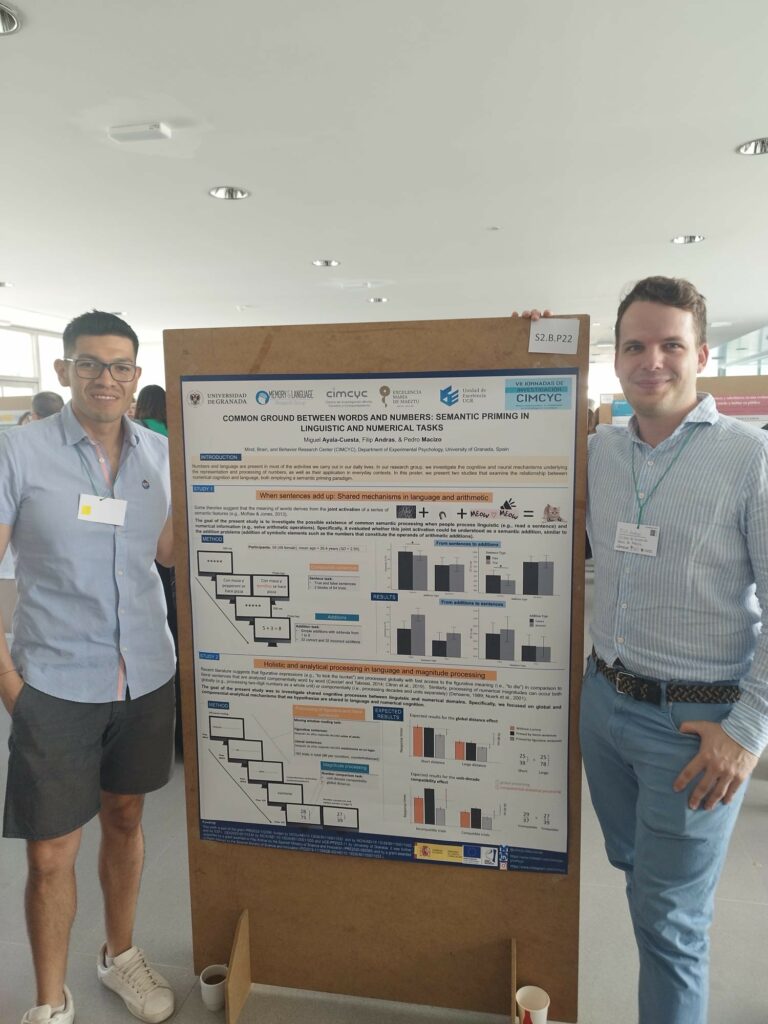
From a Language Point of View. Casado, A., Romero-Rivas, C., Rodríguez-Cuadrado, S., Oprea, M.V., Paolieri, D., Bajo, T., y Pérez, A.
In our research group, we study how one language influences the activation of the other language during linguistic comprehension and production, and how second language processing affects decision-making processes and cognitive processes such as theory of mind. In particular, we are currently studying whether congruent nouns in gender between the two languages (i.e., “mariposa” FEM-SP / “farfalla”-FEM-IT – butterfly) are easily activated compared with incongruent nouns (“oruga”-FEM-SP / “bruco”-MAS-IT – caterpillar). Moreover, we also study the effects of gender congruency to higher levels of processing such as nouns’ semantic load and its interaction with different speaker features (i.e., sex-role, sexist behavior, inclusive language use). Also, we are exploring how processing information in the second vs. first language can affect moral decision-making and theory of mind. Our results show that processing a second language (vs. the native language) produces more utilitarian responses to moral dilemmas. Also, when we process our second language, our theory of mind abilities are impaired. Finally, we also study the cognitive processes underlying text comprehension. In particular, we investigate the high-level processes of: 1) inference generation (e.g., in the sentence “It was raining, so she took the…” is very likely to infer “umbrella”); 2) comprehension monitoring (e.g., if instead of encountering “umbrella” in the previous sentence we find “raincoat”, we should be able to detect that there has been a change); and 3) revision of no longer relevant information (e.g., replacing the interpretation of “umbrella” for “raincoat”), in young vs. old adults monolingual speakers, during native text comprehension.
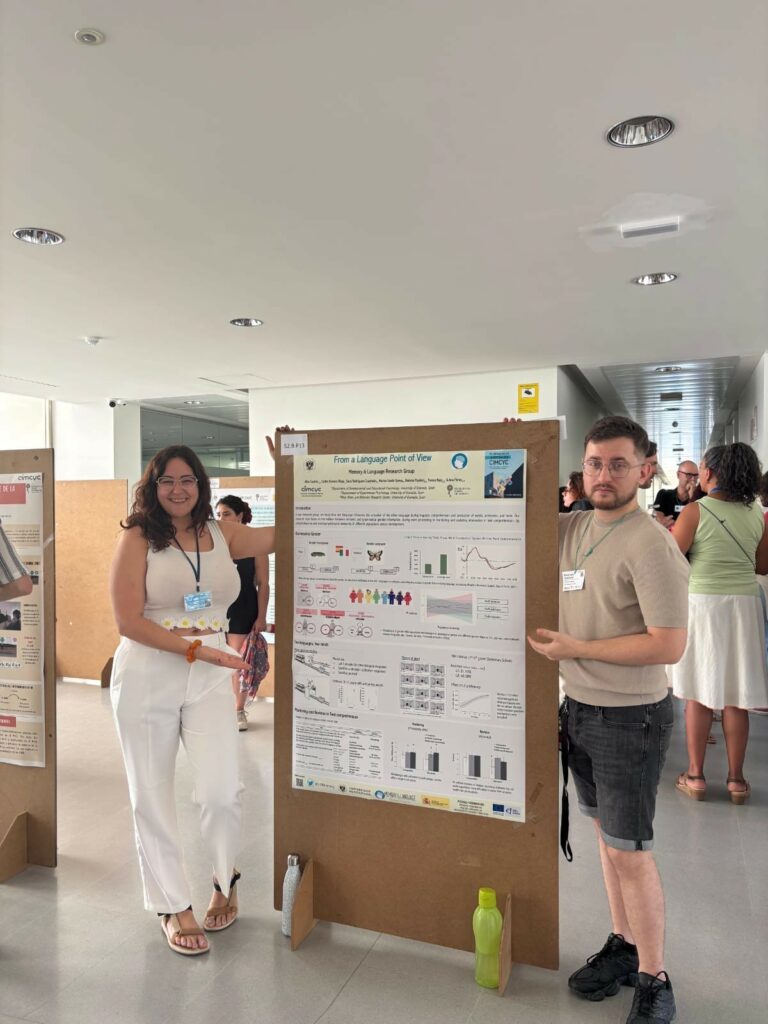
Unveiling the Role of Memory Accessibility in Cognition. Higueras-Peña, J.L., Tomás, G., Csilinkó, A., Linde-Domingo, J., Marful. A., y Bajo, T.
Memory accessibility—the degree to which stored information is available for retrieval—is a transversal property across memory systems and crucial to many other cognitive processes. Our recent work has examined how accessibility influences high-level tasks such as creativity, how external factors modulate it, and how it shapes memory representations. Models propose that accessing and recombining episodic memories underlies creative idea generation, yet retrieval can also cause fixation. In one experiment, asking participants to imagine original, task-related examples increased fixation on that example but simultaneously boosted idea originality, suggesting access to more remote associations. Conversely, our meta-analysis showed that episodic induction produced only a small benefit for idea generation, an effect that weakened after correcting for publication bias, indicating that key components of the induction remain to be identified and experimentally isolated. Social interaction alters accessibility. The collaborative memory paradigm shows that collaborative recall under turn-taking conditions spreads errors and sustains false memories relative to individual recall. Nevertheless, interaction can re-expose individuals to correct information they might otherwise forget, demonstrating that others can both impair and enhance accessibility depending on the quality of the interaction. Using representational similarity analysis of eye-tracking data, we found that the format of working-memory representations shifts with accessibility: encoding is object-specific, but during retention—especially when attention is withdrawn—it becomes more object-independent. Taken together, evidence from our studies offers new insight into how memory accessibility operates and how it can be harnessed or disrupted by cognitive strategies and everyday social contexts.
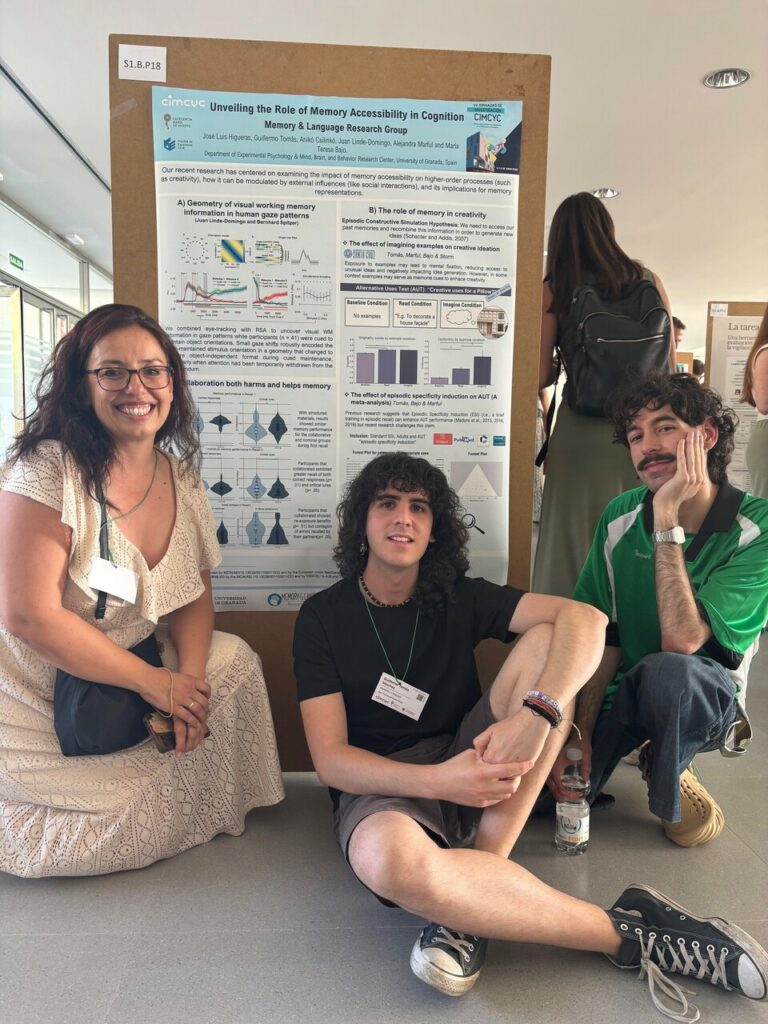
Memory is not one-size-fits-all. López-Rojas, C., Maraver, M.J., Montoro, N., Su, Z., Tomás, G., Bajo, T., y Marful, A.
From childhood memories to the languages we speak, memory is shaped by individual differences. The Memory & Language group uses behavioral and neural measures (e.g., EEG) to explore how factors such as developmental stage and bilingual experience influence memory phenomena, including false memories, prospective memory (PM), and episodic memory. Research on episodic memory has used the Episodic Specificity Induction (ESI), a procedure based on the cognitive interview used to enhance recall of episodic details. In our experiments, children and adults underwent ESI using either children-adapted cartoons or standard videos. While adults generally recalled more specific details, this age-related difference disappeared when verbal output was controlled, using child-adapted videos. Although older adults are typically more susceptible to false memories, our findings show that repeated memory practice and corrective feedback can reduce false memories in both younger and older adults. Additionally, metacognitive guidance following feedback further improves accurate recall. We are currently developing interventions that combine metacognitive training with emotional induction to support memory error correction. Our bilingualism studies reveal that prior bilingual experience and the linguistic context can influence the recall of future intentions, both positively and negatively. Bilinguals in dual-language contexts engage monitoring processes more than those in single-language settings. However, performing in a second language can hinder the recall of future intentions. By examining diverse age groups and linguistic factors, our findings highlight that memory is not only dynamic but also remarkably flexible and responsive to experience.
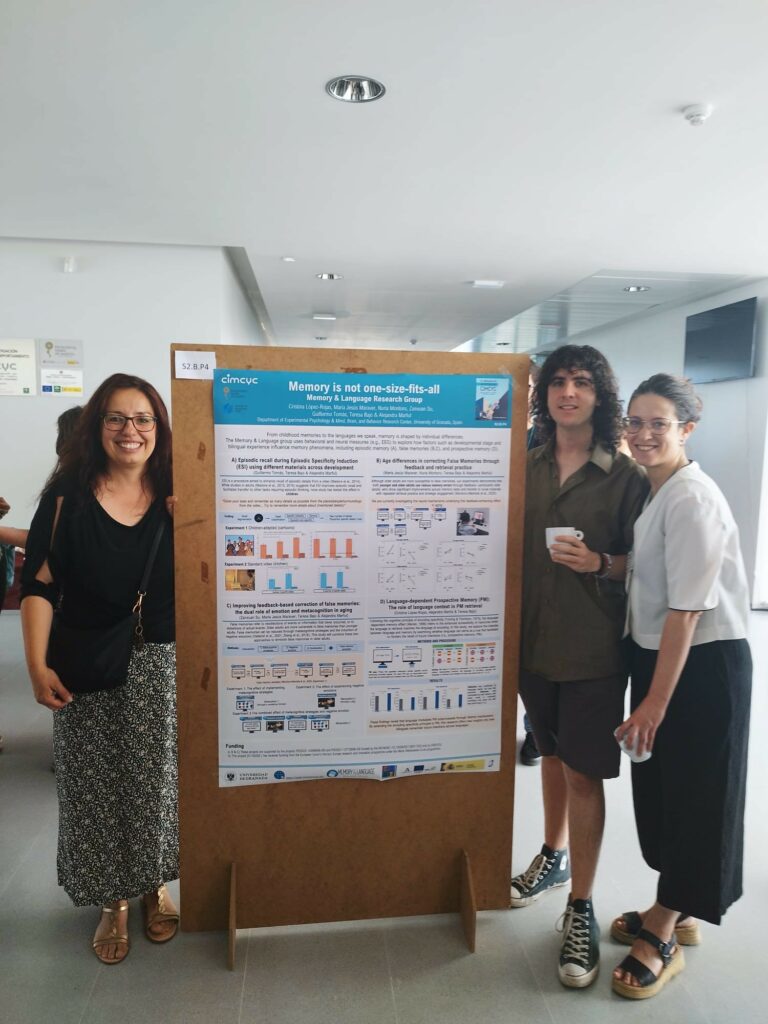
Póster presentado en la modalidad “Buenas prácticas de colaboración entre grupos del CIMCYC” — Premio al mejor póster
Bridging minds: Collaborative research on Memory & Language. Linde-Domingo, J., Bajo, T., Bernal, A., González-García, C., Funes, M.J., Hebart, M.N., Maraver, M.J., Marful, A., Martín-Arévalo, E., Ortiz-Tudela, J., Pérez, A.I., y Völler, J.
The Memory & Language group collaborates with teams in cognitive neuroscience, neuropsychology, and psychobiology at CIMCYC to advance understanding of human cognition through behavioral and neural methods (e.g., EEG, fMRI), diverse populations, and theoretical perspectives. One project explores visual perception and memory using a dataset of ambiguous images with over 100,000 human ratings. Comparing responses with neural network representations revealed that identification depends on high-level visual features. After exposure to original images, participants’ naming became more consistent and semantically aligned. Notably, clarity followed a U-shaped curve, improving with both congruent and incongruent cues, highlighting how perception and memory interact to resolve ambiguity. Another project examines sequencing of everyday actions (SEAC), such as preparing breakfast, integrating planning, error monitoring, and memory. Understanding how SEAC is affected by aging supports the development of interventions for maintaining independence and detecting early cognitive decline. In text comprehension, we study the neural basis of mental model revision. Higher white matter integrity in the right inferior fronto-occipital fasciculus (IFOF) in bilinguals is associated with stronger N400 effects during revision—suggesting a bilingual advantage in updating textual interpretations. This effect is absent in monolinguals. We also investigate memory disruptions linked to menopause, a key period given the elevated risk of Alzheimer’s disease in women. This research focuses on how estradiol decline affects the hippocampus, prefrontal, and perirhinal cortex, disrupting recollection, familiarity, and retrieval monitoring.
